Ultimate Guide to Tattoo Removal Process & Cost
If you’re like many people of the 2000’s, you may have a few tattoos that you’d like to forget ever happened.
However, it can be a bit scary to make the decision to remove a tattoo due to a fear of unnecessary pain, potentially expensive processes or the possibility of an unsuccessful removal.
Fortunately, with modern technology and innovative treatment methods, you can get that tattoo removed in a fast and efficient manner without having to undergo intensely painful treatments or face an empty bank account.
Does Tattoo Removal Work?
The short answer to this question is a resounding “yes.”
However, when it comes to whether tattoo removal works, a number of factors come into consideration.
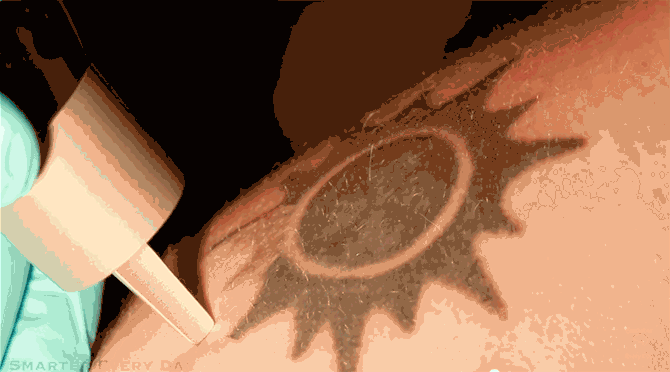 Laser tattoo removal process
Laser tattoo removal process
For example, you should choose a tattoo removal method that has been tried and proven effective. You’ll also want to be sure to seek tattoo removal from experienced and knowledgeable professionals for best results.
Laser Tattoo Removal
Essentially, laser removal of a tattoo consists of removing the ink that is deeply embedded beneath the skin’s surface. While this may be difficult to understand, the process is actually easy and stress-free for many people.
How Laser Removal Works
Laser treatment varies from patient to patient based on a number of factors that include the size, age and type of tattoo. Skin color and pigment depth also affect the technique that is used to remove a tattoo.
 How laser tattoo removal works
How laser tattoo removal works
However, the following is a simple breakdown of what you can expect during the process:
- Protective eye shields are placed over your eyes.
- A small area of skin is tested for a reaction to the laser.
- A handheld device is placed against the surface of your skin, which may feel like a pulsing sensation.
- An ice pack is applied to the treated area.
Further reading:
- Here's What Really Happens When You Remove a Tattoo
- Advanced Technology Meets Smart Skincare
- How Tattoo Removal Works
How Much Does It Cost?
Depending on the size, location and type of tattoo, you can expect to pay up to a few hundred dollars per session.
However, it’s important to keep in mind that tattoo removal often requires several sessions. The specific number of treatments required is based on each individual tattoo.
Expert opinion:
Laser tattoo removal costa specialist ranges from $50 to $500 per treatment, depending on the size and complexity of your tattoo. at
Prices from aspa, or physician practice can range from $100 to $700 per treatment. med
Plastic surgeons and dermatologists charge the most. Their prices range between $150 and $1000 per treatment.
Professional tattoos typically require 7-15 treatments, while amateur/homemade tattoos usually need 3-8
How Many Sessions Are Needed?
Again, depending on the size, location and type of tattoo being removed, you may need only a few sessions or several.
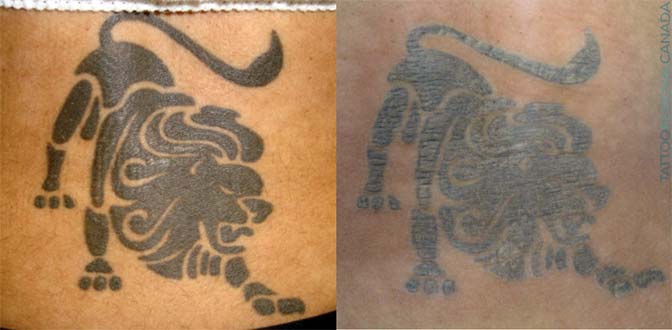 After one session of laser tattoo removal
After one session of laser tattoo removal
Your laser treatment coordinator can go over the specific details of your tattoo removal needs once you’ve had a consultation.
Expert opinion:
Take into account that there are factors for your tattoo, and your skin, that will determine how many treatments needed to remove your tattoo. Every one person, and every one tattoounique. is
All depending on these factors, anywhere from 5-15 treatments could be needed.
Some of these factors include:
- Amateureasier as they are in shallower depths of the skin. tattoos remove
- Black, red and blue colored ink are typicallycolors to remove. the easier
- Whereas light blues, and greens can be more stubborn to treat and require additional treatments.
What About Pain?
Much like with any other activity that requires a touch to the skin, the amount of pain you experience is based on your individual tolerance level.
Other factors may include your skin type, the depth of the ink beneath the skin and the size of your tattoo.
Many people describe the sensation as more of a feeling of a warm rubber band being popped repeatedly over the skin.
Expert opinions:
This mainly depends on the tattoo location and your personal pain threshold. Where there is generally more body fat the treatment will hurt less, so removing a tattoo from your buttocks will be more comfortable than removing a tattoo from your knee cap for example.
And remember, laser tattoo removal sessions only last for a fraction of the time it takes to ink your skin!
From years of experience in the tattoo removal realm, I can assure you that tattoo removal is anything but painless.
Though many people compare ithaving a rubber band snapped repeatedly across the skin, I have no tattoos and cannot speak from my own experience. with
Another comparison is bacon grease popping up and burning the skin - a sort of pain that is manageable enough knowing that you're not grabbing the frying pan and dumping it on your body.
Ultimately, there are a few things used to combat the pain (Zimmer Cryo 6, ice packs, numbing agents like topical creams or, etc.), or subdue it somewhat, but there's no getting around the pain of tattoo removal. It is what it is. injectables
Further reading:
Does Tattoo Location Matter?
In most cases, the location of your tattoo can have an effect on the removal process.
For example, fading is often slower on parts of the body located farthest away from the heart, such as the lower arms or legs.
 Before and after laser tattoo removal treatment
Before and after laser tattoo removal treatment
Alternatively, a tattoo located on the upper torso and closer to the heart may have a more rapid response to the laser removal procedure.
Expert opinions:
Placement of the tattoo is directly related toof treatments as well, the closer to the heart the tattoo is, the easier it will be to treat as the body does not have to work as hard to metabolize the ink, the farther away, the more number that additional treatments could be needed. likely it remains
Location of the tattoo on a patient's body helps us determine how far apart we should space out each removal appointment. Traditionally, the more distal the area of treatment (i.e., arms/hands) the more time we allow between appointments. The extremities receive less blood flow than areas located in a closer proximity to the heart, and therefore it takes longer for these treatment areas to heal. legs
It's important to give the body enough time to not only heal, but to remove the tattoo ink debris created by the laser session before initiating the next treatment.
Also, some areasthe patient's body are more sensitive to laser treatments. In our experience, patients have reported the most pain in areas of on fat deposition (e.g. little ). Patients with tattoos on their lower back/spine also have slightly more uncomfortable laser treatments. ankle
Why Successful Laser Tattoo Removal Relates to a Famous Kids Song?
Everyone has heard kidssing that fun song "Heads, Shoulders, Knees and Toes."
Well, Tattoo Removal Specialists are often asked if the location of a tattoo on the body affects the removal process. The answer, of course, is "Heads, Shoulders, Knees and Toes".
As you may be aware, laser tattoo removal requires blood flow to the skin where the tattoo is located in order for the body's immune system to flush out the microscopic ink particles.
Tattoos on the face generally can be removed the quickest as the Head receives far more blood flow than the Shoulders, Knees or Toes. In fact, tattoos on the feet and toes (hands and fingers, too) often take far more laser sessions than the Head or Shoulders.
Certain medical conditions which decrease blood flow to the feet or hands such as Diabetes or Raynaud's may make laser tattoo removal ineffective.
So the next time you hear your 3 year old sing "Head, Shoulders, Knees and Toes" they might be referring to Laser Tattoo Removal.
Aftercare Instruction
After each laser treatment, you’ll want to follow any instructions given to you by your laser removal specialist.
However, the following are a few basic things you should expect to do after each session:
- Change dressings at least once per day for the first three days after treatment. Make sure you wash your hands thoroughly with soap and warm water before removing the dressing.
- Apply any creams or ointments given to you or suggested by your practitioner
to - Ice packs covered with a cloth may be necessary to help reduce swelling or soreness of the treated area.
- As much as possible, protect the treated area from unnecessary bumps or stretching.
- Do NOT pick, scratch or peel the treated area. Not only can this increase the risk of infection, but it can also slow the healing process or lead to unwanted scarring.
Expert opinions:
Now that you’ve made the investment to get your tattoo removed, correct aftercare of yourtattoo is extremely important for uncomplicated healing. lasered
For the first 24 hours, keep the tattoo covered with Aquaphor, Vaseline or Aloe Vera gel along with a nonstick Telfa pad. You may ice the area for comfort by applying the ice intermittently over the treated area for 1 to 3 minutes at a time. You should not leave the ice on the area for any more than 5 minutes.
If you are able to, elevate the treated area to at least level with your heart to promote circulation. The first day, you may wash the area with gentle soap and water, but do not scrub. Reapply the bandage to the area as above to complete the first day post procedure.
If no skin breakage or blistering has occurred, you may leave the area uncovered by the second day. If a blister occurs, continue to dress the area as above until the skin heals. You may use a sterile needle to drain the blister if it is painful.
Above all, do not pick at the area or remove any crusts or scabs; these actions will not promote healing. Signs of infection include fever, yellow-green drainage, red streaks in the area and foul odor. Call the office if you suspect infection.
Keep the tattoo out of direct sunlight; use SPF 50 on the tattoo if sun exposure is unavoidable. Good hydration with water and notthe tattoo removal process. smoking promote
Your next laser treatment should be scheduled in 8 weeks minimum; peak eliminationthe lymphatic system has been shown in studies to be around 6 weeks. If the skin overlying the tattoo has not healed completely, your subsequent treatment should be delayed by a week or two. by
To help the tattoo removalprocess we advise our clients to lead a healthy lifestyleincluding a good diet, adequate sleep and drinking plenty of water.
We strongly advise smokers to cut back on how many cigarettes they smoke if they can’t quit altogether as smoking can greatly reduce effective blood flow in your body, and will actually slow down the process by up to 40%.
We also advise our clients to limit their consumption of alcohol as the removal process is hindered if your body is already working overtime to remove bad toxins associated with an unhealthy lifestyle.
Your immune system needs to be as strong as it can be if you want to help speed up the removal, because it plays a major role in the tattoo removal process. We also can’t stress enough how important it is to avoid unprotected sun exposure to the area during the tattoo removal process.
We advise all of our clients to keep the area out of the sun for at least 2 weeks prior to and after each treatment. Any kind of tan (real or fake) will affect the treatment, and laser should never be performed on a sunburn.
Further reading:
Are There Any Risks?
Although many people are thrilled at the way their skin looks once a tattoo is completely removed from their body.
However, like with any medical procedure, there are some risks involved. The most common risks include:
- Scars
- Burns
- Infection
- Hyperpigmentation
- Change in skin texture
- Hypopigmentation, especially for those with darker skin
Expert opinions:
Lasers produce short pulses of intense light that pass harmlessly through the top layers of the skin to be selectively absorbed by the tattoo pigment. This laser energy causes the tattoo pigment to fragment into smaller particles.
Typical adverse side effects include swelling andpetechiae (redness). As long as patients follow our detailed aftercare instructions, the skin will heal in about 2-7 days.
If patients do not follow proper aftercare, they risk experiencing blistering and scabbing. If the skin is not properly taken care of, this could result in skin texture changes and skin discoloration.
The fragmented particles are carried away by the body's immune system. For this reason, we ask that our patients disclose to us any medical history that affects their current health status. Patients with compromised immune systems are not good candidates for laser tattoo removal due to possible risks to their health.
Patients who have a lot of pigment in their skin or are tan at the time of treatment, are at higher risk for developing skin discoloration (hyperpigmentation, hypopigmentation, or depigmentation) from any type of light treatment, including laser tattoo removal. For this reason, we advise keeping the tattoo covered or applying sunblock between treatments.
Patients who are taking photosensitizing medications are at higher risk for having a strong reaction to any type of light treatment. For this reason, patients are advised to discontinue anyphotosensitizing medications 2 weeks prior to a laser tattoo removal treatment.
Because not every color of ink reacts to the wavelengths that are currently available for laser tattoo removal, there is a risk that your tattoo may not be completely removed.
Complications are relatively uncommon in the hands of a skilled practitioner. We consider the most common complication simply to be failure to completely remove a tattoo. While tattoo removal lasers are the best and safest option for tattoo removal presently, some tattoos prove to be refractory to laser therapy.
Allergic reactions to tattoo ink is another complication. We see this most commonly with red tattoo ink. Tattoo ink is basically hidden from within the immune system within cells of the dermis. When we liberate the ink from the intracellular space we reintroduce it to the immune system which sometimes produces a significant allergic reaction.
Blisters are a more common complication. We endeavor to reduce the incidence of blisters with our protocols as blistering is an unwanted reaction which is uncomfortableto the client and can prolong recovery. Most blisters heal without incident and long term outcomes are similar to non-blistered clients.
Textural changes in which the surface of the skin feels rough or has a change in the natural skin color can also be seen. Many clients with tattoos may be unaware that they haveexisting scar or textural changes in their skin because the tattoo effectively hides it. However, we palpate (touch) each tattoo prior to beginning treatment. If you can feel the tattoo edges, then there is pre-existing scarring or textural changes. Removing the tattoo makes these changes more obvious and clients may mistakenly believe that these changes were induced by the laser. The laser also may induce textural changes in the healing process as well.
Hypopigmentation is an off-target complication in which themelanocytes , specialized cells within the skin that produce melanin, aredamage by the laser. Thismore commonly occurs with short wavelengths used to treatred and brown pigments as melanin also absorbs these wavelengths. We exercise more care in treating clients with dark skin types, particularly African Americans as it is possible to completely whiten the skin. The good news is thatmelanocytes usually fully recover in these patients as they are protected in the sweat ducts and hair follicles and usually repopulate the area.
Infections are very uncommon. Some medical conditions that require treatment with drugs that depress the immune system can increase this risk. We often see clients on medications to treat lupus, rheumatoid arthritis, or other autoimmune disease. These clients are at increased risk of infection and we usually have a conversation with the patients’ doctors as part of our risk assessment.
Laser tattoo removal is generally safe in experienced hands and complications are relativelyuncommon but are easily managed by a physician adequately trained in tattoo removal. Long term results are excellent in mostcases though every practitioner may encounter tough to remove tattoos.
Tattoo Cover-Up
Many people who have an unwanted tattoo simply choose a cover-up option. While this may seem like a viable choice, there are a number of factors to consider.
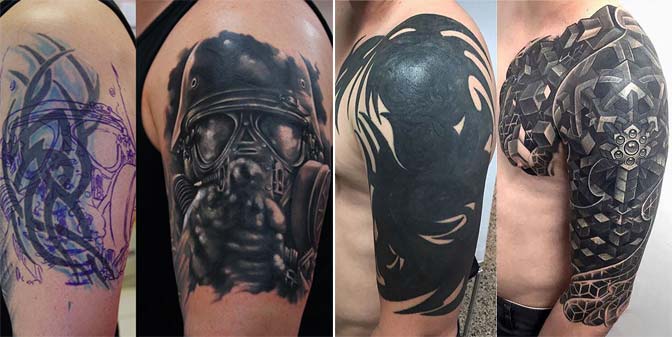 Tattoo cover up (before and after)
Tattoo cover up (before and after)
Whether you no longer want that tiger growling on the side of your leg or hope to remove an ex-lover’s name from your chest, it’s important to know the facts about tattoo cover-ups.
How Tattoo Cover-Up Works
Essentially, a tattoo cover-up is what it seems in that the process involves covering up an existing tattoo with another, larger or more expressive tattoo.
However, due to the nature of what all a cover-up entails, many times your tattoo artist may recommend that you undergo laser treatment before they can begin working on the cover-up.
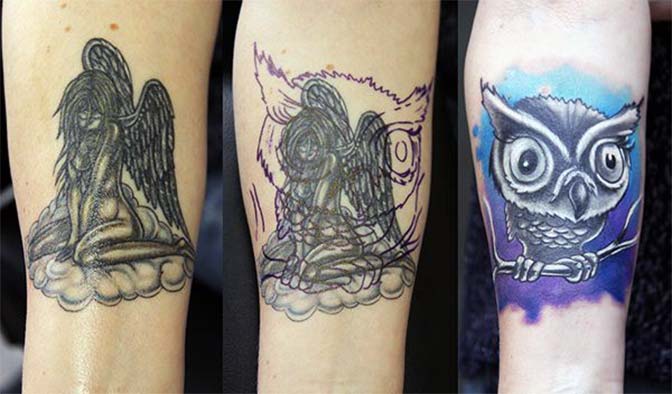 How
How
Although it may seem redundant, laser treatments can fade the tattoo in a manner that will enable your tattoo artist
to make your cover up
Further reading:
What You Need to Know Before Covering-Up
If you want to end up with a tattoo cover-up that’s worth showing off, there are a few things you need to consider before making any decisions.
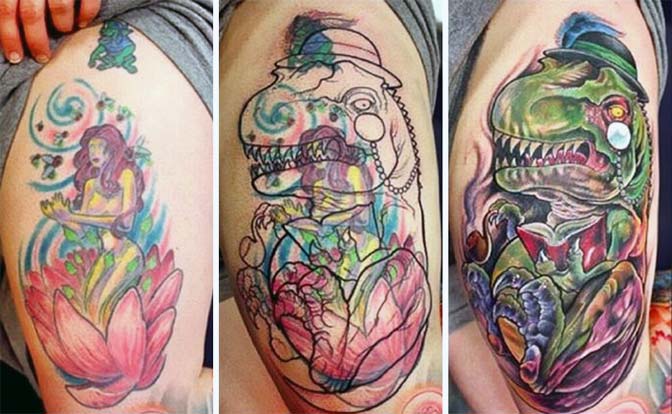 Covering up process
Covering up process
Although doing a good cover up can be difficult, it is possible to get a tattoo covered in a way that appears not like a cover-up, but rather like a good original tattoo.
Things to note include:
- The new tattoo design should be three or four times the size of the original.
- Most often, the new design will need to be custom-drawn to ensure best results.
- The best colors to use on a tattoo cover-up are cool colors like purple, green and blue.
- If the old tattoo is dark, the new tattoo may have to have a significant amount of dark shading.
Tattoo Removal Cream
You may be one of the many people who wish to have a tattoo removed, but you simply do not feel financially able to pay for laser treatment therapy.
If that sounds familiar, you’re definitely not alone.
That’s why tattoo removal cream seems like a reasonable solution for people like you. However, there are a few things you need to know about tattoo removal cream.
How the Cream Works
Although tattoo removal creams may seem like a viable option for fading that unwanted tattoo, the truth is that these creams do not penetrate the second layer of skin.
Instead, the harsh chemicals (usually TCA) used to develop the cream bleaches the outer layer of
skin
 Before and after tattoo removal cream
Before and after tattoo removal cream
That means, although your tattoo may seem lighter in color, there is no way a tattoo can actually disappear
with the use of tattoo removal cream
Tattoo Removal Cream Pros and Cons
Pros
- Some tattoo fading may occur.
- Creams cost less than other tattoo removal methods.
Cons
- Tattoo removal creams cannot remove tattoos.
- Creams can cause painful burning and scarring.
- Creams consist of harsh, potentially damaging, chemicals.
Be Careful With Other Methods
When it comes to tattoo removal, it’s best left to the professionals.
Fortunately, modern technology and innovation has brought us to a place where tattoos are removed much more easily and without causing significant harm to your body.
Although there are still a few tattoo removal methods to explore aside from laser treatment, it’s important to use extreme caution when considering these tattoo removal options.
Removing with Salt
Tattoo removal procedures that include the use of salt (salabrasion) or saline do not actually remove the tattoo from the skin.
However, the salt can lighten your tattoo. This method, while inexpensive, can take a long time to produce any results.
In addition, the level of skin damage that can occur with the use of salt can lead to infections, inflammation and possible scarring.
Dermabrasion
While dermabrasion may work well for small tattoos located on the face or hands, it’s generally not recommended for
larger tattoos located
Not only can dermabrasion leave unsightly scars, but it also may not adequately remove the pigment left from the tattoo.
Intense Pulsed Light Therapy
Much like many other tattoo removal methods, IPL can cause more harm than good when attempting to remove a tattoo from your skin.
The treatment can lead to scarring, hypopigmentation and unwanted ink retention.
DIY Tattoo Removal Methods
Possibly one of the worst things you can do is try to remove a tattoo on your own.
Without the skills and expertise of a professional in the industry, you can end up causing yourself a great deal of pain, anguish and unnecessary expense.
Although many people attempt to take tattoo removal into their own hands with DIY salt mixtures, at-home dermabrasion and many other methods, the truth is that the safe, effective removal of a tattoo requires the knowledge and skills that an industry professional should possess.
Successful Tattoo Removal
In addition to tattoo removal cost, you should look for the best tattoo removal method that will bring you the most benefits.

Embed:
When seeking assistance from a medical professional, you can ask questions like "Does tattoo removal hurt?" and "What Can I Expect?"
Most instances of extreme tattoo removal pain are due to people trying to take matters into their own hands.
Whether you're looking to remove the name of an ex-girlfriend or boyfriend, hoping to eliminate a misspelled word or simply tired of your old tattoo, tattoo removal can be an excellent choice.
However, one thing is certain; you should always seek guidance from a trained professional with experience in tattoo removal procedures
BTW, pikachu cover up tattoo idea from the infographic is made by Lindsay Bugbaker